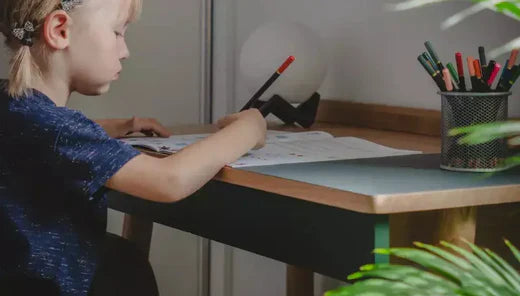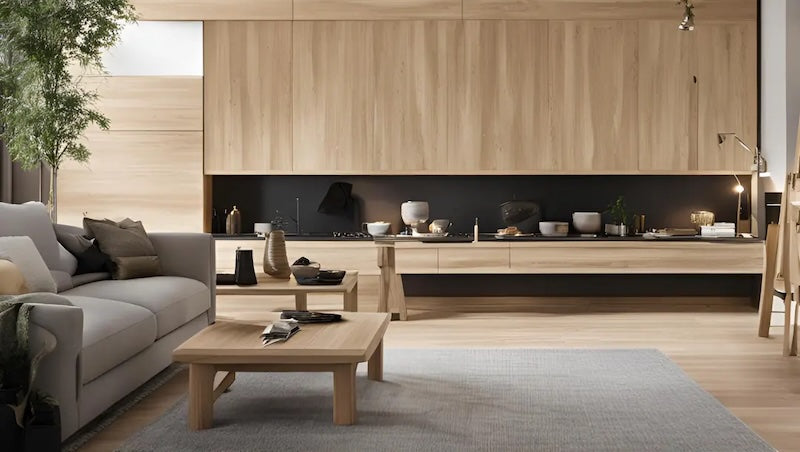Choosing a child's desk is not only a matter of aesthetics, but above all health and effectiveness in learning. In the subject of a child's room, it is especially important that it is properly adapted to the needs and spatial possibilities. How to properly set up a desk in a small child's room? Many parents ask themselves this question, wanting to create an ergonomic place for their child to learn and play. This piece of furniture plays a key role in shaping the correct posture, health and organization of the work space, regardless of the size of the room.
Contents:
- Where to place a desk for a child?
- What is the desk position relative to the window?
- How to properly set up a desk? Child's room arrangement.
- Setting Up a Child's Desk. How to Do It?
Where to place a desk for a child?
Choosing the right desk for your child should take into account several key aspects that will affect the comfort and functionality of its use. First of all, the right height of the desk is important - the furniture should be set at a height that the child can sit and write comfortably, which supports comfort while learning.
Another important factor is the location of the desk with access to a source of natural light . It is a good idea to place the student's workspace near a window, which will provide adequate lighting, especially when doing homework during the day. This will reduce the need to use artificial light and improve the child's visual comfort.
It is equally important to provide the child with an ergonomic place, both in terms of the desk and chair settings. Properly positioned furniture will help maintain the correct posture, which is crucial for the child's health, especially during the period of intensive growth.
Finally, it is worth paying attention to the height of the desk and the space underneath it. The space should offer enough storage for books, notebooks and other school materials, which will help keep things tidy and make it easier to focus on learning.
What is the desk position relative to the window?
The correct positioning of the desk in relation to the window is a key aspect that can significantly affect the comfort of work and study. When you position it to make the most of the natural light source, you will improve concentration and reduce eye fatigue. However, improper positioning can lead to problems, such as irritating reflections on the computer screen, which effectively reduce work efficiency.
A desk under the window in a child’s room – is it a good solution?
A desk by the window in a child's room has its advantages, but also some disadvantages. On the one hand, access to natural light is a real benefit, especially when they spend long hours at work. Daylight improves mood and supports concentration. On the other hand, such a position can lead to reflections on the computer screen, which can be tiring for the eyes.
How to arrange your desk to avoid glare on your screen?
When arranging a study area in a child's room, it is worth taking care of the appropriate desk positioning. Where you place it is of great importance for work comfort and eye health. One of the most common problems is reflections on a computer or tablet screen. Fortunately, they are easy to avoid.
It is best to place the desk at an angle to the window. This will allow daylight to enter the room, but will not shine directly on the screen. This simple solution will allow the child to focus on learning, without tiring reflections on the monitor or tabletop.
If the room is very bright, consider blackout blinds or curtains. They will help reduce too much light, especially on sunny days. They will also be useful if your child uses a screen in the evening – then softer lighting is much better for the eyes.
Remember also about a good lamp for the child's desk. It should have an adjustable arm to easily adjust the direction of the light. Thanks to such simple tricks, the place for studying will become comfortable and friendly. And your child will be able to focus on their tasks without unnecessary obstacles.
How to properly set up a desk? Child's room arrangement.
Providing your child with an ergonomic place is the foundation of their health and comfort while learning. A well-planned space not only supports proper posture, but also increases work efficiency.
This is especially important during the period of intensive development. Proper arrangement of the child's room, adapted to the child's growth, can prevent spine problems and reduce muscle fatigue.
Ergonomic chair – the key to proper posture
Choosing a chair is equally important. What chair should you choose so that your child sits properly? An ergonomic chair with adjustable seat height and armrests is the perfect solution.
Such a chair supports the spine, helps maintain the correct posture while sitting, which has a huge impact on the child's health. In combination with the appropriate height of the desk, an ergonomic chair creates an ideal space for learning - comfortable and healthy.
Check out the chair that grows with your child.
Desk and chair height – how to adjust to the child’s height?
Adjusting the height of the desk and chair to the child's height is a key element of ergonomics. The right height of the desk for children provides a comfortable position for learning, which directly affects comfort and health. To ensure proper posture, remember a few rules:
The right desk setup means adjusting it to a height that allows the child to rest their feet freely on the floor. If the feet hang down, you can consider a footrest – this will provide adequate support. The child's elbows should be at the level of the tabletop or slightly higher, which will allow for a natural positioning of the hands when writing or working on a computer.
The chair is also key. Adjustable models are the best choice because they are easy to adjust to the child's changing height. It is important that the back is supported along its entire length and the knees are bent at a right angle. A chair with adjustable seat depth can also be a good solution - this provides better thigh support.
Remember that proper positioning not only supports correct posture, but also makes the child feel more comfortable. This makes it easier for them to focus on learning and avoid fatigue.
Here you will find a desk with adjustable height.
Children's Desk Lighting - Desk Lamp and Blackout Blinds
Good lighting for a child's desk is essential for a comfortable place to study. Natural light is ideal, but not always sufficient – especially in the evening or on cloudy days.
In such situations, a desk lamp becomes irreplaceable. It should provide bright, even light that does not tire the eyes. A lamp with an adjustable arm will work best, because it allows you to easily adjust the angle of the light to the current needs of the child. Remember that for right-handed people, the light should fall from the left side, and for left-handed people - from the right, so as not to create a shadow on the work surface.
If you decide to place a desk under a window in your child's room, blackout blinds can be a great convenience. They can easily regulate the amount of light coming in and prevent the sun from reflecting off the computer screen or blinding your eyes. This is especially important at noon, when the sunlight is at its most intense. Blinds also help create a pleasant learning environment by eliminating contrasts between light and dark areas in the room.
Good lighting is not just a lamp or blinds - it is a whole that promotes health and concentration. Thanks to this, you can provide your child with an ideal space where they can work comfortably and effectively.
Setting Up a Child's Desk. How to Do It?
Setting up a desk in a small child's room, where every centimeter counts, requires careful consideration. The key is to make the best use of the available space. The aspects of the desk's positioning and its location will affect the arrangement of the child's room. This can help create a place that will be conducive to both learning and play, while not overwhelming the interior.
Corner desk - maximum use of space
Corner desks are a great solution for small rooms. They use a corner of the room that is often left unused, creating a comfortable nook to work in. With this arrangement, you will provide your child with enough space to study and store supplies, while not taking up too much space in the middle of the room.
Additionally, they can be equipped with shelves above the top, which allows you to store books or school supplies, saving space in the rest of the room. Corner desks are great for a small child's room that needs a separate area for studying, but wants to keep room for play and rest.
How to place furniture directly under a bunk bed?
Bunk beds with built-in desks are a real hit in small rooms. They combine functionality with space saving, allowing you to conveniently organize a sleeping and study area in one structure. Thanks to this solution, the space in the room remains more open, which is important for children who need space for movement and play.
Placing a child's desk under the bed can be enriched with cabinets or shelves, which will provide additional storage space. This solution will be especially appreciated by parents of school-age children who require a well-organized place to study and at the same time want to make the most of the space in the room.
DIY Children's Desk from a Tabletop - How to Adapt to a Small Space?
Are you having trouble arranging a child's room? DIY from a countertop is a creative option for small rooms, where flexibility and individual adjustment are important. The self-assembled countertop can be attached to the wall, which saves space and allows you to adjust the size of the surface to the available space.
Arranging a desk by the window is a great way to use natural light, which promotes concentration and creates a friendly atmosphere for learning. If space is extremely limited, you can use a foldable top, which takes up almost no space when folded. Thanks to such solutions, setting up a child's desk will be easier. It is also possible to choose materials and colors that will perfectly fit into the arrangement of the child's room.
Desk organizers – how to keep things tidy?
Maintaining order in a small room is especially important, because any unnecessary thing can cause chaos. Desk organizers help to organize the space quickly and easily. These can be simple containers for pens, colorful baskets for books or sets with drawers for small items.
In the arrangement of a child's room, wall-mounted organizers are great - boards with pockets or shelves that do not take up space on the countertop but provide additional storage space. A good idea is also to introduce a color-coding system, which will make it easier for the child to quickly find the items they need.
A well-organized desk allows your child to focus better and use the available space more effectively.







